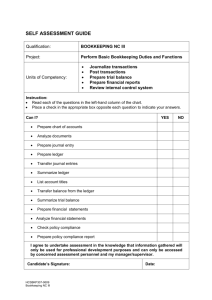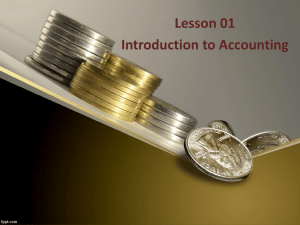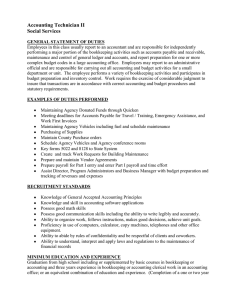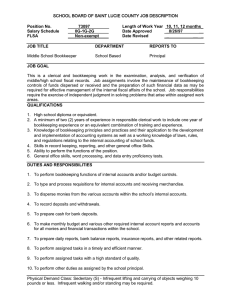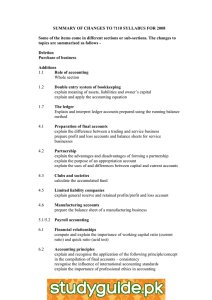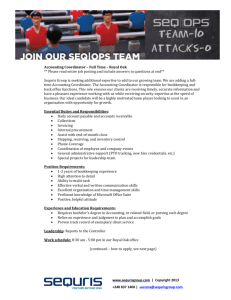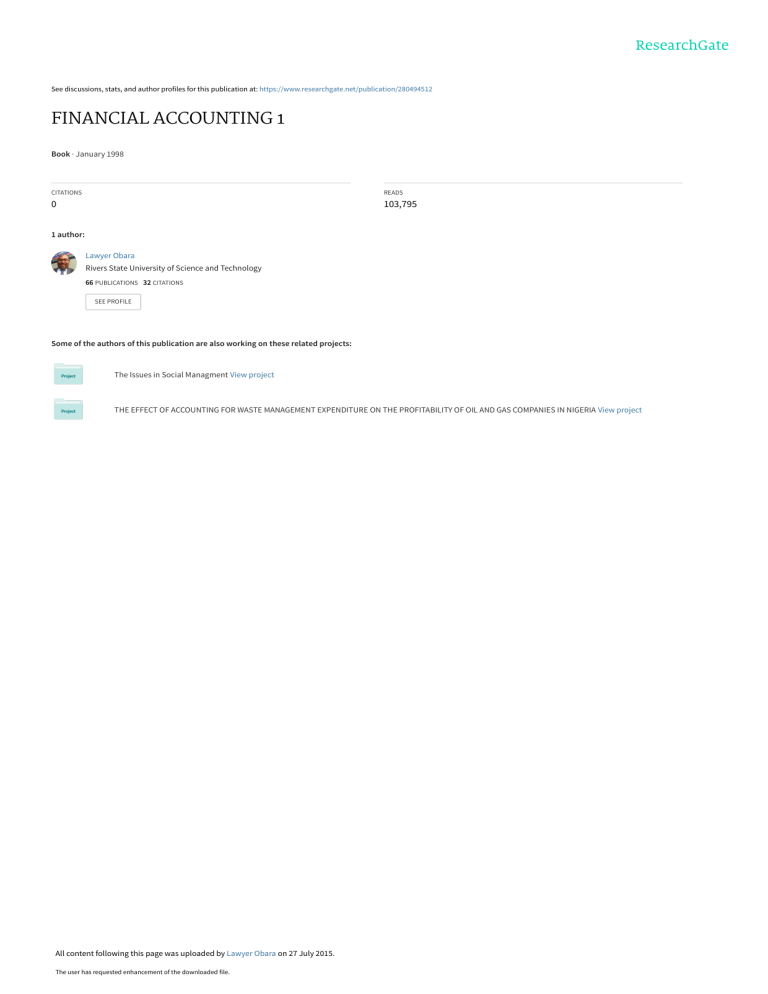
See discussions, stats, and author profiles for this publication at: https://www.researchgate.net/publication/280494512
FINANCIAL ACCOUNTING 1
Book · January 1998
CITATIONS
READS
0
103,795
1 author:
Lawyer Obara
Rivers State University of Science and Technology
66 PUBLICATIONS 32 CITATIONS SEE PROFILE
Some of the authors of this publication are also working on these related projects:
The Issues in Social Managment View project
THE EFFECT OF ACCOUNTING FOR WASTE MANAGEMENT EXPENDITURE ON THE PROFITABILITY OF OIL AND GAS COMPANIES IN NIGERIA View project
All content following this page was uploaded by Lawyer Obara on 27 July 2015.
The user has requested enhancement of the downloaded file.
., .
,"2. 1"2~ 0
,
~
~ ~ ~r
1., -:-1
., ":'1
..
LI;:I
1 =" ~ -";" 1 '""\
!~"l~'~
1 "":" ~ I.... ,I ~
I!
~"'\-":' ..
"
... ~. l I
'1
i" .
9111N00331 ,
1113NVNI:I ·
In this book, Financial Accounting I, the authors,
Messrs N.A. Ukpai, B.D Kiabel and i.c Obara of
the Rivers State University of Science and
Technology, Port Harcourt, lucidly treated the
topics at the introductory level of Financial
Accounting in our Universities and other related
tertiary institutions. The topics are adequate for
theinstitute of Chartered Accountants of Nigeria
(ICAN) stage one examinations and other
professional bodies.
The concepts and principles are defined, explained
and illustrated with practical local examples. The
focus of this book is to show how financial
accounting data are accumulated and how
periodic financial statements are prepared to
enable the student interpret and use accounting
information intelligently and effectively.
The ease to read design of the book practice
questions and exercises with solutions at the end of
all chapters specially distinguished the book and
recommends it for reading to all accounting
students and practitioners
FINANCIAL
ACCOUNTING 1
N. A. Ukpai
B. D. Kiabel
L. C. Obara
Dept. of Accountancy
Rivers State University of Science and Technology
Port Harcourt
Nigeria
Reprinted by:
DAYIDSTONES PUBLISHERS LTD.
Port Harcourt
~.
Second reprint by:
DAVIDSTONES PUBLISHERS LTD.
Chief Wali Estate, Rumualogu,
Port Harcourt, Nigeria.
Tel.: 08035079193
FirstPublished, 1998
Pen Paper Publishers
First reprint by:
HORIZON CONCEPT
ISBN' 978-2873-87-X
All rights reserved. No part of this publication may be reproduced,
stored in a retrieval system, or transmitted in any form or by any
means, electronic, mechanical photocopying, recording or
otherwise, without the prior written permission of Davidstones
Publishers Ltd.
A.
:;.,~
Preface.
..
_ " ,. "."
Acknowledgn·;,·nts _.,_,mm..'''''''·
Forward
_".""",,",,"""
CHANERl
Definition of Accounting.."""".".
Book Keeping defined-."""",,'"
Book Keeping & Accoudimnl!
CBAPTER2
History, Principles a.'ld GmmmI
Principles and Com-ent:iaIJmui;
Basic Concepts, Principies.a
CHAPTER 3
Accounting in the Opet'"
The role of AccountingillulII
Different Types of &KiIIaIlii
Financial Accounting ~
Users of Fi:naJ'!ciaI Jnk;ii:i8iIIiIII
CHAPTEll4
Double Entrv"'1
'.Ii~
Advantages of OIl
IiIaIIIl
The Accoun..n-r JFs S +,.
Debits and CrecBs,,_~­
Expenses and Rev;
...
The Account and Ihl!-
.
.
Ilh
·~b
Jai~,
aa..
TAinJ: \,; CUNTENTS
Preface.
.
xiii
Acknowledgln'.·nts........................................................................................................ ix
Forward..............
x
CHAPTER 1
Definition of Accounting.........................................................................................
Book Keeping defined
·· ·..·..··
···· ·..··...........................
Book Keeping & Accounting ···..····
·..· · ·· ····..·..· ·..·.............
1
3
3
C(IAPTER2
J.
?:5
History, Principles and Convention of Accounting............................
Principles and Conventions
Basic Concepts, Principles and Convention · ·
·......................
6
7
7
CHAPTER 3
Accounting in the Operation of an Enterprise.......................................
The role of Accounting in an Enterprise
Different Types of Business Organizations
Financial Accounting Statements
Users of Financial InformatioI1............................................................................
14
14
16
17
19
CHAPTER 4
Double Entry Book-keeping
:..........
Advantages of Double Entry System of Bookkeeping
The Accounting Equation
Debits and Credits
;...................................................................
Expenses and Revenue Accounts
The Account and the Double-Entry Principles
23
23
24
25
27
28
CHAr
CHAPTERS
Source Documents and Books of Original Entry
Books of Original Entry (Journal)
Sales Day Book
Purchase Day Book
The Two-Column Cash Book
.
The three-Column Cash Book
Cash Discounts
'.. , "
Trade Discounts
.
Contra Entry..................................................................................................
,
Use of Folio Columns.................................................................
,.,
Petty Cash Book
"
The ImprestSystem
,
CHAPTER 6
Classification of Capital and Revenue Items
Classification of Account
CHAPTER 7
The Ledger
The General Ledger
Balancing an Account in the Ledger
Trial Balance
"
.
.
36
37
38
38
42
42
4~
4..±
45
46
41'
49
............... 59
.
60
", .................. 61
. ............... 64
.
65
.
67
, ..,
CHAPTER 8
Errors
,.
Errors not Affecting Trial Balance Agreement
Correction of Errors
Errors Revealed by the Trial Balance
Suspense Account.....................................................................................
.
.
.
.
79
79
81
84
85
Adjustnv
or Financial AccC'u:
Accrued E>_:t·enses
-._..
Prepaid Expenses
__ .
Accrued Income
-_ .
Income in Advance
__..
Treatment of bad Debt and Pros
Provision for Discount on I.>eblI!lr
Provision for Discount on Cred
CHAPTER 10
The Final Account
Trading Account
Profit & Loss Account
_ .
- ..
__ .
CHAPTER11
Control Account
_
.
Debtors Control Account _ .
Creditors Control Account _ . .
Sales Ledger Control Accomnllt
Control Accounts and Doublhl
CHAPTER 12
Method of Calculating Depre
RevalnationMethod ......
Unit \.J Production Method . Machine Hour Method -_ . Sum of years Digits -_ . Accounting for Depreciat:icmmI.
The Use of the Provision Ii<x '[
Depreciation & Inflation .._ .
_m .
CHAPTER 13
The Bank Account and BM*
Types of Bank Account
:?aying-in-Book
-_ .
_m
ii
,
36
37
"",,,,,,,,,.. ,,,,,,,,,
_
__
.".. "
"" ""''''' ''"
"
"."
~,
38
. 38
.
42
. 42
...." " _
.......m"
4~
4-J
mm_ _••••
........... M ....... _ _ ~_~... • • • • • • • • • • • • • • CHAr
Adjustm.
or Financial Accounts
Accrued EAl,enses
Prepaid Expenses
Accrued Income
Income in Advance
Treatment of bad Debt and Provision for Bad Debt
Provision for Discount on Debtors
Provision for Discount on Credits
98
99
101
104
107
109
CHAYfER10
The Final Account
Trading Account
Profit & Loss Account
112
112
113
CHAPTER11
Control Account
Debtors Control Account
Creditors Control Account
Sales Ledger Control Account
Control Accounts and Double Entry Principle
161
162
162
163
166
CHAPTER 12
Method of Calculating Depreciation
Revalnation Method
Unit", Production Method
Machine Hour Method
SUIn of years Digits
Accounting for Depreciation
The Use of the Provision for Depreciation Account...
Depreciation & Inflation
172
175
175
175
175
177
179
186
CHAPTER 13
The Bank Account and Bank Reconciliation Statements
Tvpes of Bank Account
F'aying-in-Book
19J.
191
192
')5
9b
,1::;
'":t:_
.................._.._
. . . . . . . . ._ _...
" " _­ ...
46
4 E­
49
. . . . . . . . . __
59
,........._......_................... 60
"·. , ·_···········
61
" " __
".·..".·. ··_····..·
" · ···_··
64
65
67
.......... ·
79
..................................... 79
,.·
81
.............. 84
............ 85
111
WithdrawaLs.
Parties to a OK),..I'
Kind of Cheque
Dishonored cheques
.
Bank Reconciliation Statements ..
Timing Differences
.
Informational Differences
Reconciliation Practices
Overdrafts
.
193
.... 194
. 194
.. 195
197
.
198
199
H.
CHAPfER14
Manufacturing Account
Analysis of Cost
Direct Materials
Direct Labour
Direct Expenses
Factory Overhead
Administration Overhead
Stock Manufacturing business
H
.
.
.
.
.
•
.
200
205
H
.
,.
219
219
220
220
.221
.221
.222
223
.
.
_
_ "
_ _
CHAPTER 15
Single Entry and Incomplete Records
Statements of Affairs under Incomplete Records
Profit & Loss under Single Entry.
"."
Conversion ofSingle Entry into Double Entry
IV
CHAPTER 18
J0int\'enture-~
:-.:: at'u re c f Joint VemIItm
\ ~3.:r-. Charac lie ,jsI!lU"pC'l
A ccc>wJJtiDIII:.. iPlrlUU!!iilm
CHAPIa:B
243
o;..s,pbg"w4wP11nttb
244
245
COtij"S!. . .::._",....~--Acc()ii.IIII" "
""~'"
252
'i1
CH~
!Ii"
Depat'j!i'i'
CHAPfER16
Accounts of Non-Profit-Making Organizations.
Receipts and Payments Account
Subscription in Arrears and in Advance
Sundry Matters
CHAPTER 17
Partnership Accounts
,
The Origin of a Partnership
General Principles of Partnership
Partnership Agreem~
Adjustment in PartIrlu
Admission of a Pa:rIIDr
Revaluation of Pa.r1I:IIrnJl
Admission of a Paun1:II:
Methods of\'alumg"\(
Methods of Dea..lingll
Partner
_.._-_._ .
Retirement of a Patrtr
Amalgama tion of Pa!l
Partners' Cash/ ~
Dissolution of PaII'tlIlUt!
Rule for Distri~
262
263
ill
All~
Int:er-Det-" 1111
264
273
CHAPTEaa
cc~pany Mt,,'."'"
':-:_-pes of C';UFli!iit ,I:.
"
"'
,
"
,
,
,
of'"
284
:onn4tionof~
284
285
Certifialle
!\i~anchaa.A
",, ., , , , ,.,
, 193
.... 194
... 194
..... 195
...." 197
........ 198
........ 199
.,
200
"
205
. ,. ,."""._
. ,........._
".,,,,,,,._
"......._
".".,,_
....,.,..__
219
219
220
220
221
221
"...,,,_ ,222
. . . . " '_
223
"'..."'_....243
.........__...244
,.. . . " ,.,._ 245
Partnership Agreement
Adjustment in Partnership Accounts
Admission of a Partner
Revaluation of Partnership Assets
Admission of a Partner Goodwill
Methods of Valuing Goodwill in Partnership
Methods of Dealing with Goodwill on Admission of a new
Partner
~
Retirement of a Partner
Amalgamation of Partnership Business
Partners' Cash/Bank Account
Dissolution of Partnership
Rule for Distribution of Assets on Dissolution
, 286
289
302
302
307
, 309
311
313
318
320
324
326
CHAPTER 18
Joint Venture Accounting
Nature of Joint Ventures
Main Characteristics
Accounting Procedure
336
336
336
337
CHAPTER 19
Conversion of a Partnership Business to a Limited Liability
Company ,
Accounting Procedures and Entries for the Conversion
349
349
CHAPTER 20
Departmental Accounts '"""
Allotment of Indirect Expenses ···..·..·
Inter-Departmental Transfers ., .. ,,,,.,
379
379
380
........,_., 252
. ", ,.__._.262
,.,., _263
,
,
" "__264
,
",
",.., , ,.__ 273
,,,,.,.,,.284
""".."'". "'""",
284
, ,. , . , , , , , , . , , ..,285
CHAPTER 21
Company Accounts
,
Types of Companies
Formation of Company
"
Certificate of Incorporation "
Memorandum of Association
"
,
"
·..·
v
"' "'
390
, 392
,394
395
395
The Articles d , '
.,396
The Statutory D u , 3 9 7 Share Capital.......................
.
.J97
The Issue of Shares
,
......400
Shares issued at a Premium
.
,.,
405
Calls
, ,..,
418
Calls ill Advance
418
Calls in Arrear
418
Forfeiture of Shares
419
Debentures
4·26
Final Accounts of Limited Companies
427
The Balance Sheet
430
Cash flow Stat.!::!!
Preparaticr. lQ,r ill
Statement ot 50~
Sources of \~iIJ\8
PreparationlolE:fI
Index .....--"..,,"""""
CHAPTER 22
Limited Liability Companies: Preparation of Final Accounts
for Publication
443
Published Balance Sheets
444
Profit & Loss Accounts of Companies
.,447
Directors Report
448
CHAPTER 23
Financial Statement Analysis
Financial Ratio Analysis
Standards of Comparison
Liquidity Ratios
Liquidity Receivables
Debt Ratios
Coverage Ratios
Profitability Ratios
Ratios that Relate Profit to Investment
Uses and Limitations of Ratio Analysis
CHAPTER 24
Funds Flow Statements
The Furpose of Funds Statement
Thee .." ',lvcptional Funds Statc.nents
vi
-------
-~--
~
.458
458
459
460
461
463
463
465
.,466
.467
..484
.,
485
..l86
·:ilIlli:.
,'.'~~,,~:'\
11.
"
..
.,
.l~
"196
"197
397
AOO
.... 405
""""".. .,_ 418
"",.",,,.,,.,__ ,418
CashfIowStatements
Preparation of a Cash Flow Statement
Statement of Source and Application of Funds
Sources of Working Capital
Preparation of Funds Flow Statements
Index
,
, ,
''''''''''''''''''_'_'.,.418
. """",,-·--..419
""""""..-_.426
. ".·. _.· -427
,,,,,,,,,,.,_.430
IIIIds
"""",._443
".",,,_444
",.,,,,,.,-447
"""",,-448
,·,,-458
"""",••...........458
.•"""".",."..459
,,,,,,,,,,,,,,,,.,,,.460
".""""""",.",,461
""".".",,,.,,,,,,463
"",,,.,,,,,,,,,,,,,:463
, , , , , ,..,,,,,,,,465
",,,,,,,,,,,,,,,,,,,,466
"",,,,,,,,,,,..,,,467
""', .... ~.""-::
,
,
48-:­
496
.492
494
..496
,
507
PREFACE
Financial Accounting 1 is designed for USi: :.:' 3. first year
accounting course at the polytechnic and university iev e. it describe
the fundamental concepts and principles that underbe accounting
information, shows how accounting data are accurr.u.ated, and
initiates the student into the following specific objectives
1.
2.
3.
Developing a general understanding of financial reports and
analyses that students will find useful in their personal affairs
regardless of their fields of specialization.
Providing a strong foundation for subsequent courses in
. finance and general business, and
Initiating the course work leading to a career in accounting.
The concepts and principles that guide financial accounting
are continuously emphasized and explained so that students will be
able to generalize a1,-1 apply their knowledge in a 11 situations. As the
concepts and principles are gradually introduced, they are defined,
explained and illustrated with practical application such that
students do not hold abstract concepts in limbo before they see how
concepts applied. The central focus of this book is to show how
financial accounting data are accumulated and how periodic
financial statements are prepared so that students can interpret and
use accounting information intelligently and effectively. The mark of
this book is in the careful integration and effectively. The mark of this
book is in the careful integration of conceptual principles and their
application to specific business situations.
The material has been arranged to allow flexibility of usage by
both students and instructors. It has been arranged in such a way that
every chapter aids in the understanding of the next chapter. At the
end of every chapter, assignments and problems have been provided
to test student's ability to com pliehend.
N, A. UIKPAI
B. D. KIABEL
L. C. OBARA
June.2004
viii
I
11.·
...."
:~i
.t~f
%
The publication of tra
of many people.
We do express our ~';
of Management ScJne
Technology (RSCST .
Our specific thanks g:[
Chief P. o. Obele. Dr .
B. Johnnie, Dr. 0
Tamunomiebi, mr. D
Hamilton.
We are grateful to the
(WAN) West Africar­
us use their past exarr
Association of AccC':n.IT
John Bossi.
For the encouragemei
and above all, we ac
guidance and protects
year
lItrill: describe
:' ,D:JroUnting
dl*d, and
,ill .first
'l!II~and
1!llulIDJJn1liil1 affairs
t
,lI:IlllUl'Ses in
l:!lCQlI'lting.
l ,KJCOUTIting
fuamIIs will be
IIIIinmDmms.. As the
BE defined,
i such that
Eyse€how
,~Thow
.. periodic
fiIllil!!llll.JMet and
"liJIIRmark of
IIIlIIIliiidt of this
es oUDd. their
ACKNOWLEDGMENT
The publication of this book was made possible with the assistance
of many people.
We do express our gratitude to the staff and students of the Faculty
of Management Science, Rivers State University of Science and
Technology (RSUST), Port Harcourt, Nigeria for their contributions.
Our specific thanks go to the following colleagues: Dr. J. 1. M. Braide,
Chief P. O. Obele, Dr. D. W. Maclaytom, Prof. B. A. Fubara, Prof. P.
B. Johnnie, Dr. O. O. Eni, Mrs. T. A. Udenwa, Mr. M. D.
Tamunomiebi, mr. D. S. MacOdo, Rev. T. A. Amangala and Mr. LI. 1.
Hamilton.
We are grateful to the Institute of Chattered Accountants of Nigeria
(WAN) West African Examinations Council (WAEC), for allowing
us use their past examination questions. We are also grateful to the
Association of Accountancy Students and to our medical doctor Dr.
John Bossi.
For the encouragement and understanding, we thank our families
and above all, we are most grateful to God Almighty for his
guidance and protection.
N. A. UKPAI
B. D. KIABEL
1. C. OBARA
'i]ljfusageby
t:liII'WaY that
11plIIU. A t the
{::TlI F'!"C",i ded
ix
FOREWORD
The book has attempted to present a flexible and teachable yet
demanding textual base for financial accounting. It has presented a
balanced coverage to the problem of finding an ideal relation
benveen an understanding of accounting procedures and the
liability to produce and use accounting information effectively.
Accounting has
who care to defi
drawn from the
1.
"The eel
periods
(accomj
2.
Accours
commm
judgme
Amero
The book has provided a strong foundation for subsequent courses
in business finance and administration and also initiated the course
work leading to a career in accounting.
3.
AccoUDl
measure
total eIrr."
possessi
I recommend this book to first year students of accounting, finance
and general management in institutions of higher learning in
Nigeria.
4.
AecOUD
The organization of this text allows flexibility of usage by both
students and instructors as each chapter aids in the understanding
of the next chapter. There are a wide range of questions, review
exercises and problems at the end of each chapter to assist and test
user's comprehension.
E. O. OBELE, FCA
Burser
Rivers State University of Science and Technology
Port Harcourt
SUlIUDiilllll
transadiD
f inanc:iiiaIl
AII'lel'iiJic3
1971l
The definitic:lrJms;
each of tlJeIa
omittedordoa!m
For exampie., I
keepingasped
definitionillllllllitJi
June,2004
x
----- - - -
CHAPTER 1
DEFINITION OF ACCOUNTING
wet
cia
i1Lm
Accounting has been defined in as many ways as there are people
who care to define it. The following definitions have been arbitrarily
drawn from the literature of its meaning.
the
oth
mg
1.
"The central purpose of accounting is to make possible the
periodic matching of costs (efforts) and revenues
(accomplishments)" (Littleton, 1953).
2.
Accounting is the process of identifying, measuring and
communicating economic information to permit informed.
judgments and decisions by the users of the information.
American Accounting Association (AAA, 1966).
3.
Accounting is a discipline which is concerned with the
measurement and communication of certain aspects of the
total environment relating to the interplay of man and his
possession and utilization of scarce means's" (YU, 197, "
4.
Accounting is an art of recording, classifying and
summarizing in a significant manner and in terms of moncv,
transactions and events which are, in part, at last, of cl
financial character, and interpreting the results thereof.
American Institute of Certified Public Accountants (AICPA,
1971).
ilf'W
IlleSt
InCe
m
The definitions should be seen as complementing one another since
each of them attempts to highlight some aspect of accounting
omitted or dampened by the others.
For example, the AICPA definition is quite detailed on the book­
keeping aspects of accounting, elaborating as it were, on the other
definition and it includes interpreting of bookkeeping information as
1
Financial Accounting 1
belonging to the accounting function. Specifically, the AICPA
definition can, for the purpose of simplicity, be divided into two
parts; viz.:
The part that deals with recording transactions; and the part that
deals with interpreting, classifying and summarizing the results of
the final part. The first is what we call "bookkeeping" . Accounting
or accountancy includes bookkeeping as well as the second part
that is, classifying, summarizing and interpretation of the
information made available by bookkeeping.
Thus, Recording commits the transactions and event to writing.
The recording may be in the form of pen-pencil markings made by
hand or it may be accomplished by various mechanical and
electronic devices.
ClassifiJing involves sorting the many transactions in an orderly and
systematic manner. Special forms and procedures are devised to
facilitate this process. A mass of isolated transactions conveys little
meaning when considered individual; the data become useful, only
when sorted according to predetermined classes. Transactions
must be understood before they can be classified.
Summarizing brings the accounting data together in a form that
further enhances their usefulness. It is not the single business act
but the sum of all the operations of a day, a week, a month, or a year
,that has the greatest significance. Therefore summaries of
operations and their effect on property and rights to property are
prepared at intervals. These reports are made to the managers of the
enterprises and to others who need the information.
Interpreting the result of operations as summarized in the various
reports is an essential part of accounting. Interpretation frequently
takes the form of percentage analyses and ratios.
2
Comparisons betweer. .:::..­
reveal important tre:l.ds,:
significant deYe10F~
explained, omphasized.em
BOOK KEEPIKG DEF1N1
Book keeping is the art jJJD'fr l
business, or an indivichImaJl1lJiJ
order to obtain necessary iimm
The definition has fOllll'diirH
a)
Bookkeepingis.-IL.aI
b)
It is concerned wiIIII
typeof~lii:
c)
The tra.nsad:iol&_
nct irr i termsof1wpam
dI
The 'J~ci bod. ~
the'Ci~"'iIIiit
8()()K1ti'ii'riINI&;...-J­
TheflE DIs ~_@" ........;
thetwo'..-'
dematG1J1Iiri:8
recording cibbo"'­ __
may be resP"*!I_I. . . .~
or only a small. srgil"iMliIJ,_
department stoee, w.:ImtlGll~
nature.
Accounting is priInaJit.r '0
records, the preparatima ,1lID1tI
recorded data 'and the pllilei
direct and review the~,·
i"lIe' A:CPA
in to two
~,dl
iItue part that
iInte results of
_JIKlroun tin g
'Siiecvnd part
iI:nlOO'll of the
lilt lID writing.
IDJC5 made by
::Mnical and
1IIIJ'm-derlyand
r~ devised to
cenvevs little
eusefut only
Transactions
form that
blisiness act
ftili. or a year
rmmaries of
property are
:m.agers of the
II all
~
Jr,
the various
frequently
00
Comparisons between different dates and periods of time may
reveal important trends. From these ratios and trends, the most
significant developments in the affairs of a business may be
explained, emphasized, and guided.
BOOKKEEPING DEFINED
Book keeping is the art of recording the financial transactions of a
business, or an individual in terms of money and in a set of books in
order to obtain necessary information when required.
The definition has four distinctive parts:
a)
Book keeping is an art; not a science.
It is concerned with recording financial and not any other
b)
type of transactions:
c)
The transactions must be recorded in terms of money and
not in terms of quantity.
d)
The object of book keeping is to provide information about
the conduct and status of the business.
BOOKKEEPING AND ACCOUNTING
There is some confusion over the distinction between
"bookkeeping" and "accounting". This is due in part to the fact that
the two axe related and that there is no universally accepted line of
demarcation between them. In general, bookkeeping is the
recording of business data in a prescribed manner. A bookkeeping
may be responsible for keeping account of the records of a business
or only a small segment such as a portion of a business accounts in a
department store. Much of the work of the book-keeper is clerical in
nature.
Accounting is primarily concerned with design of the system of
records, the preparation of reports based on the interpretation of
recorded data 'and the preparation of reports'. Accountants often
direct and review the work of bookkeepers. The larger the busine-ss.
3
Financial Accounting 1
the greater the number of gradations in responsibility and
authority. The work of accountants at tl.; beginning levels may
include some bookkeeping. In any event it is apparent that the
accountant must include some bookkeeping. In any event, it is
apparent that his accountant must possess a much higher level of
knowledge and analytical skill than is required of the book keeper.
More specifically, the accountant should be concerned with
more than the recording phase. He should, for instance, carry out
the following functions:
1.
Directing and coordinating the work of the book keeping
staff and designing and maintaining accounting systems
adequate to the needs of the particular business.
2.
Preparing periodical accounts of profit and loss, and
financial position statements in a form which will be of
assistance to the management and other users not only in
appraisingpastresults, but in formulating future policy.
3.
To bring to light significant facts to enable errors in
management and policy to be rectified and reforms and
economies to be introduced through careful scientific
analysis of accounting records.
Diff eTielr1ltni@
..,
In~-0luOP1]
or anart1JE
.....,
\\r;Ail 00'
11i
aL<~'::'~
+.
In
t.~ OilIlXlC~l
jiffer .&iam
''''~lJlf~I''
-'}//UI:!!.
'!'"
4.
To advise and consolidate the accounting records of
branches and subsidiaries;
5.
To install and direct costing systems.
6.
To advise management and give effects to their policy on all
matters affecting the business in its financial and
accounting aspects.
4
--------
r
ill
r.i;;~:t
.':'",
~;.'
Definition ofAccounting 1
EXERCISE
iity and
!"ll'1ds may
IItt lhat the
WftllI:, it is
1.
Differentiate between accounting and book keeping.
9'levelof
Ildteeper.
2.
In your opinion, should accounting be considered a 'science'
or an art? Explain.
3.
What do you think is the most important function of the
accountant in a business organization?
4.
In the accounting process, how does the art of summarizing
differ from that of interpreting?
m'lIIfd with
. ICiaITYOut
k ]keeping
g systems
iIoss, and
ril be of
1l."Jt onlv in
poticy.
.I
errors in
and
scientific
ICJOIlS
I&UTds of
)100· on all
rial and
5
View publication stats


